Exploring Spatially Non-Stationary and Scale-Dependent Responses of Ecosystem Services to Urbanization in Wuhan, China
Abstract
1. Introduction
2. Materials and Methods
2.1. Study Area
2.2. Data Source and Preprocessing
2.3. Methods
2.3.1. Flowchart of the Method
2.3.2. Evaluation of Ecosystem Services and Mapping of Their Changes
2.3.3. Measurement of Urbanization
2.3.4. Geographically Weighted Regression
2.3.5. Measurement of Non-Stationarity and Scale Analysis
3. Results
3.1. Spatial Patterns of Ecosystem Services and Biodiversity Changes
3.2. Spatial Patterns of Urbanization Indicators
3.3. Responses of Ecosystem Services to Urbanization
3.3.1. Globally Responses of Ecosystem Services by OLS
3.3.2. Sensitivity of Non-Stationarity to Bandwidth in GWR
3.3.3. Spatially Non-Stationary Responses of Ecosystem Services by GWR
3.3.4. Model Performance of GWR and its Comparison with OLS’s
4. Discussion
4.1. Scale Effects in Spatially Non-Stationary Responses of Ecosystem Services to Urbanization
4.2. Implications for Ecologically Friendly Urban Planning
4.3. Strengths and Limitations
5. Conclusions
Author Contributions
Funding
Conflicts of Interest
Appendix A
| ESs | Methods | Quantification Unit | Calculation Process |
|---|---|---|---|
| GP | Regression equation between GP and vegetation condition index (VCI) | kg ha−1 yr−1 | GPi = GPt × VCIi / Ʃ (VCIi); VCIi = (NDVIi- NDVImin)/ (NDVImax- NDVImin) × 100% GPi: the annual grain product in the ith cultivated land grid; GPt: total value of the annual grain product in the whole region; n: number of cultivated land grids; NDVIi: annual average NDVI value at the ith cultivated land grid; NDVImax, NDVImin: maximum and minimum values of annual average NDVI across all cultivated land grids. |
| CS | Carnegie-Ames-Stanford Approach (CASA) model | g cm −2 yr −1 | NPP = APAR × ε; APAR = SOL × FPAR × 0.5; ε = T1 × T2 × W × ε* NPP: net primary production; APAR = vegetation—absorbed photosynthesis available radiation; ε: light use efficiency; SOL: total global solar radiation; FPAR: fraction of PAR absorbed by vegetation canopy; T1, T2: temperature stress coefficients; W: water stress coefficient; ε*: maximum light use efficiency under ideal conditions |
| BC | Habitat quality module in InVEST (v.3.2.0) | Dimensionless (0–1) | Q = Hj (1− (Dx2/Dx2 + k2)) Q: habitat quality; Hj: habitat suitability score for LULCj; Dxy: total threat level in grid × with LULCj; k: half-saturation constant (see InVEST user’s guide for further details on this method) |
| EP | Universal soil loss equation (USLE) | t ha−1 yr−1 | A = R × K × LS × (1 − C·P) A: annual soil erosion per unit area; R: perception erosion factor; K: soil erodibility factor; L: slope factor; C: cover management factor; P: soil conservation supporting practices factor |
References
- Millennium Ecosystem Assessment, Ecosystem and Human Well-being: General Synthesis; World Resource Institute: Washington, DC, USA, 2005.
- Fisher, B.; Turner, R. Ecosystem Services: Classification for Valuation. Biol. Conserv. 2008, 141, 1167–1169. [Google Scholar] [CrossRef]
- Boyd, J.; Banzhaf, H. What Are Ecosystem Services? The Need for Standardized Environmental Accounting Units. Ecol. Econ. 2007, 63, 616–626. [Google Scholar] [CrossRef]
- Haines-Young, R.; Potschin-Young, M. Revision of the Common International Classification for Ecosystem Services (CICES V5.1): A Policy Brief. One Ecosyst. 2018, 3, e27108. [Google Scholar] [CrossRef]
- Díaz, S.; Pascual, U.; Stenseke, M.; Martín-López, B.; Watson, R.T.; Molnár, Z.; Hill, R.; Chan, K.M.A.; Baste, I.A.; Polasky, S.; et al. Assessing nature’s contributions to people. Science 2018, 359, 270–272. [Google Scholar] [CrossRef] [PubMed]
- Zhao, Q.; Wen, Z.; Chen, S.; Ding, S.; Zhang, M. Quantifying Land Use/Land Cover and Landscape Pattern Changes and Impacts on Ecosystem Services. Int. J. Environ. Res. Public Health 2020, 17, 21. [Google Scholar] [CrossRef] [PubMed]
- Bugmann, H.; Cordonnier, T.; Truhetz, H.; Lexer, M.J. Impacts of business-as-usual management on ecosystem services in European mountain ranges under climate change. Reg. Environ. Chang. 2017, 17, 3–16. [Google Scholar] [CrossRef]
- Qin, K.; Li, J.; Yang, X. Trade-Off. and Synergy among Ecosystem Services in the Guanzhong-Tianshui Economic Region. of China. Int. J. Environ. Res. Public Health 2015, 12, 14094–14113. [Google Scholar] [CrossRef]
- Seto, K.C.; Güneralp, B.; Hutyra, L.R. Global forecasts of urban expansion to 2030 and direct impacts on biodiversity and carbon pools. Proc. Natl. Acad. Sci. USA 2012, 109, 16083–16088. [Google Scholar] [CrossRef]
- Delphin, S.; Escobedo, F.J.; Abd-Elrahman, A.; Cropper, W.P. Urbanization as a land use change driver of forest ecosystem services. Land Use Policy 2016, 54, 188–199. [Google Scholar] [CrossRef]
- Foley, J.A.; DeFries, R.; Asner, G.P.; Barford, C.; Bonan, G.; Carpenter, S.R.; Chapin, F.S.; Coe, M.T.; Daily, G.C.; Helkowski, J.H.; et al. Global consequences of land use. Science 2005, 309, 570–574. [Google Scholar] [CrossRef]
- Baró, F.; Gómez-Baggethun, E.; Haase, D. Ecosystem service bundles along the urban-rural gradient: Insights for landscape planning and management. Ecosyst. Serv. 2017, 24, 147–159. [Google Scholar] [CrossRef]
- Keniger, L.E.; Gaston, K.J.; Irvine, K.N.; Fuller, R.A. What are the Benefits of Interacting with Nature? Int. J. Environ. Res. Public Health 2013, 10, 913–935. [Google Scholar] [CrossRef] [PubMed]
- Lovasi, G.S.; O′Neil-Dunne, J.P.; Lu, J.W.; Sheehan, D.; Perzanowski, M.S.; MacFaden, S.W.; King, K.L.; Matte, T.; Miller, R.L.; Perera, F.P.; et al. Urban Tree Canopy and Asthma, Wheeze, Rhinitis, and Allergic Sensitization to Tree Pollen in a New York City Birth Cohort. Environ. Health Perspect. 2013, 121, 494–500. [Google Scholar] [CrossRef] [PubMed]
- Xu, G.; Jiao, L.; Yuan, M.; Dong, T.; Zhang, B.; Du, C. How does urban population density decline over time? An. exponential model for Chinese cities with international comparisons. Landsc. Urban Plan. 2019, 183, 59–67. [Google Scholar] [CrossRef]
- Li, B.; Chen, D.; Wu, S.; Zhou, S.; Wang, T.; Chen, H. Spatio-temporal assessment of urbanization impacts on ecosystem services: Case study of Nanjing City, China. Ecol. Indic. 2016, 71, 416–427. [Google Scholar] [CrossRef]
- Peng, J.; Tian, L.; Liu, Y.; Zhao, M.; Wu, J. Ecosystem services response to urbanization in metropolitan areas: Thresholds identification. Sci. Total Environ. 2017, 607, 706–714. [Google Scholar] [CrossRef]
- Yuan, Y.; Wu, S.; Yu, Y.; Tong, G.; Mo, L.; Yan, D.; Li, F. Spatiotemporal interaction between ecosystem services and urbanization: Case study of Nanjing City, China. Ecol. Indic. 2018, 95, 917–929. [Google Scholar] [CrossRef]
- Yao, X.; Zeng, J.; Li, W. Spatial correlation characteristics of urbanization and land ecosystem service value in Wuhan Urban. Agglomeration. Trans. Chin. Soc. Agric. Eng. 2015, 31, 249–256. [Google Scholar]
- Lyu, R.; Zhang, J.; Xu, M.; Li, J. Impacts of urbanization on ecosystem services and their temporal relations: A case study in Northern Ningxia, China. Land Use Policy 2018, 77, 163–173. [Google Scholar] [CrossRef]
- Zhang, Y.; Liu, Y.; Zhang, Y.; Liu, Y.; Zhang, G.; Chen, Y. On the spatial relationship between ecosystem services and urbanization: A case study in Wuhan, China. Sci. Total Environ. 2018, 637, 780–790. [Google Scholar] [CrossRef]
- Qiu, B.; Li, H.; Zhou, M.; Zhang, L. Vulnerability of ecosystem services provisioning to urbanization: A case of China. Ecol. Indic. 2015, 57, 505–513. [Google Scholar] [CrossRef]
- Wan, L.; Ye, X.; Lee, J.; Lu, X.; Zheng, L.; Wu, K. Effects of urbanization on ecosystem service values in a mineral resource-based city. Habitat Int. 2015, 46, 54–63. [Google Scholar] [CrossRef]
- Leung, Y.; Mei, C.-L.; Zhang, W.-X. Statistical tests for spatial nonstationarity based on the geographically weighted regression model. Environ. Plan. A 2000, 32, 9–32. [Google Scholar] [CrossRef]
- Wang, Y.; Li, X.; Zhang, F.; Wang, W.; Xiao, R. Effects of rapid urbanization on ecological functional vulnerability of the land system in Wuhan, China: A flow and stock perspective. J. Clean. Prod. 2020, 248, 119284. [Google Scholar] [CrossRef]
- Ke, X.; van Vliet, J.; Zhou, T.; Verburg, P.H.; Zheng, W.; Liu, X. Direct and indirect loss of natural habitat due to built-up area expansion: A model-based analysis for the city of Wuhan, China. Land Use Policy 2018, 74, 231–239. [Google Scholar] [CrossRef]
- Kuri, F.; Murwira, A.; Murwira, K.S.; Masocha, M. Predicting maize yield in Zimbabwe using dry dekads derived from remotely sensed Vegetation Condition Index. Int. J. Appl. Earth Obs. Geoinf. 2014, 33, 39–46. [Google Scholar] [CrossRef]
- Field, C.B.; Randerson, J.T.; Malmström, C.M. Global net primary production: Combining ecology and remote sensing. Remote Sens. Environ. 1995, 51, 74–88. [Google Scholar] [CrossRef]
- Monteith, J.L.; Moss, C.J. Climate and the Efficiency of Crop Production in Britain [and Discussion]. Philos. Trans. R. Soc. Lond. 1977, 281, 277–294. [Google Scholar]
- Haase, D.; Schwarz, N.; Strohbach, M.; Kroll, F.; Seppelt, R. Synergies, Trade-offs, and Losses of Ecosystem Services in Urban. Regions: An Integrated Multiscale Framework Applied to the Leipzig-Halle Region., Germany. Ecol. Soc. 2012, 17, 22. [Google Scholar] [CrossRef]
- Gonzalez, A.; Cardinale, B.J.; Allington, G.R.; Byrnes, J.; Arthur Endsley, K.; Brown, D.G.; Hooper, D.U.; Isbell, F.; O′Connor, M.I.; Loreau, M. Estimating local biodiversity change: A critique of papers claiming no net loss of local diversity. Ecology 2016, 97, 1949–1960. [Google Scholar] [CrossRef]
- Sharp, R.; Tallis, H.T.; Ricketts, T.; Guerry, A.D.; Wood, S.A.; Chapin-Kramer, R.; Nelson, E.; Ennaanay, D.; Wolny, S.; Olwero, N.; et al. InVEST 3.2.0 User’s Guide. The Natural Capital Project; Stanford University: Stanford, CA, USA, 2015. [Google Scholar]
- Reyers, B. Incorporating anthropogenic threats into evaluations of regional biodiversity and prioritisation of conservation areas in the Limpopo Province, South. Africa. Biol. Conserv. 2004, 118, 521–531. [Google Scholar] [CrossRef]
- Wei, Y.; Huang, Y.; Li, G. Reproductive isolation in sympatric Salvia species sharing a sole pollinator. Biodivers. Sci. 2017, 25, 608–614. [Google Scholar] [CrossRef]
- Kandziora, M.; Burkhard, B.; Muller, F. Interactions of ecosystem properties, ecosystem integrity and ecosystem service indicators-A theoretical matrix exercise. Ecol. Indic. 2013, 28, 54–78. [Google Scholar] [CrossRef]
- Anselin, L. Local Indicators of Spatial Association—LISA. Geogr. Anal. 2010, 27, 93–115. [Google Scholar] [CrossRef]
- Bai, X.; Shi, P.; Liu, Y. Society: Realizing China′s urban dream. Nature 2014, 509, 158–160. [Google Scholar] [CrossRef]
- Su, S.; Xiao, R.; Jiang, Z.; Zhang, Y. Characterizing landscape pattern and ecosystem service value changes for urbanization impacts at an eco-regional scale. Appl. Geogr. 2012, 34, 295–305. [Google Scholar] [CrossRef]
- Fotheringham, A.S.; Brunsdon, C.; Charlton, M. Geographically Weighted Regression: The Analysis of Spatially Varying Relationships; John Wiley and Sons: New York, NY, USA, 2003. [Google Scholar]
- Tu, J.; Xia, Z.-G. Examining spatially varying relationships between land use and water quality using geographically weighted regression I: Model. design and evaluation. Sci. Total Environ. 2008, 407, 358–378. [Google Scholar] [CrossRef]
- Fotheringham, A.S.; Charlton, M.E.; Brunsdon, C. Spatial variations in school performance: A local analysis using geographically weighted regression. Geogr. Environ. Model. 2001, 5, 43–66. [Google Scholar] [CrossRef]
- Fotheringham, A.S.; Charlton, M.E.; Brunsdon, C. Geographically weighted regression: A natural evolution of the expansion method for spatial data analysis. Environ. Plan. A 1998, 30, 1905–1927. [Google Scholar] [CrossRef]
- Osborne, P.E.; Foody, G.M.; Suárez-Seoane, S. Non-stationarity and local approaches to modelling the distributions of wildlife. Diversity 2007, 13, 313–323. [Google Scholar] [CrossRef]
- Charlton, M.; Fotheringham, S.; Brunsdon, C.J. GWR 3: Software for Geographically Weighted Regression; Spatial Analysis Research Group: Newcastle, UK, 2003. [Google Scholar]
- Forbes, D.J. Multi-scale analysis of the relationship between economic statistics and DMSP-OLS night light images. GIScience Remote Sens. Environ. 2013, 50, 483–499. [Google Scholar] [CrossRef]
- Faehnle, M.; Söderman, T.; Schulman, H.; Lehvävirta, S. Scale-sensitive integration of ecosystem services in urban planning. GeoJournal 2015, 80, 411–425. [Google Scholar] [CrossRef]
- Yang, Y.; Wang, K.; Liu, D.; Zhao, X.; Fan, J.; Li, J.; Zhai, X.; Zhang, C.; Zhan, R. Spatiotemporal Variation Characteristics of Ecosystem Service Losses in the Agro-Pastoral Ecotone of Northern China. Int. J. Environ. Res. Public Health 2019, 16, 1199. [Google Scholar] [CrossRef] [PubMed]
- Hsieh, H.-L.; Lin, H.-J.; Shih, S.-S.; Chen, C.-P. Ecosystem Functions Connecting Contributions from Ecosystem Services to Human Wellbeing in a Mangrove System in Northern Taiwan. Int. J. Environ. Res. Public Health 2015, 12, 6542–6560. [Google Scholar] [CrossRef]
- Liao, J.; Shao, G.; Wang, C.; Tang, L.; Huang, Q.; Qiu, Q. Urban sprawl scenario simulations based on cellular automata and ordered weighted averaging ecological constraints. Ecol. Indic. 2019, 107, 16. [Google Scholar] [CrossRef]
- Ye, Y.; Su, Y.; Zhang, H.O.; Liu, K.; Wu, Q. Construction of an ecological resistance surface model and its application in urban expansion simulations. J. Geogr. Sci. 2015, 25, 211–224. [Google Scholar] [CrossRef]
- Antognelli, S.; Vizzari, M. Ecosystem and urban services for landscape liveability: A model for quantification of stakeholders’ perceived importance. Land Use Policy 2016, 50, 277–292. [Google Scholar] [CrossRef]
- Antognelli, S.; Vizzari, M. Landscape liveability spatial assessment integrating ecosystem and urban services with their perceived importance by stakeholders. Ecol. Indic. 2017, 72, 703–725. [Google Scholar] [CrossRef]
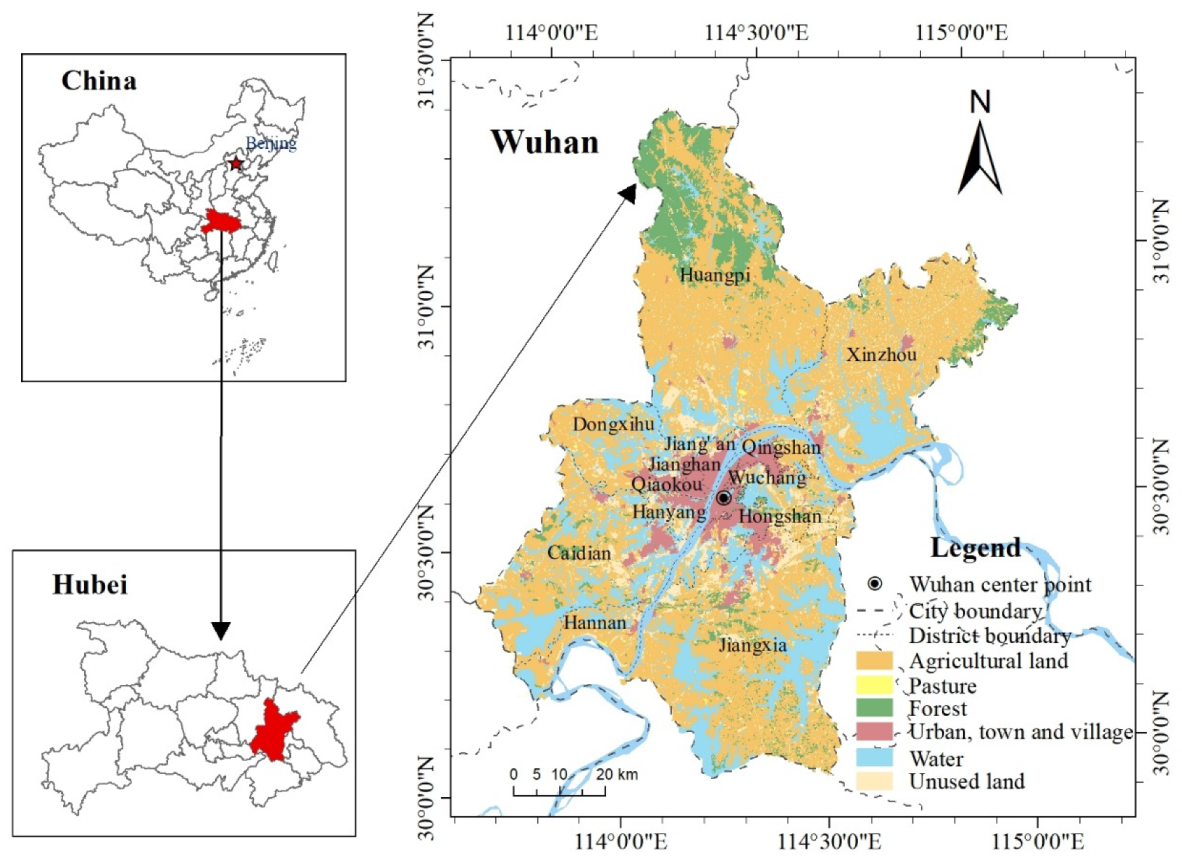
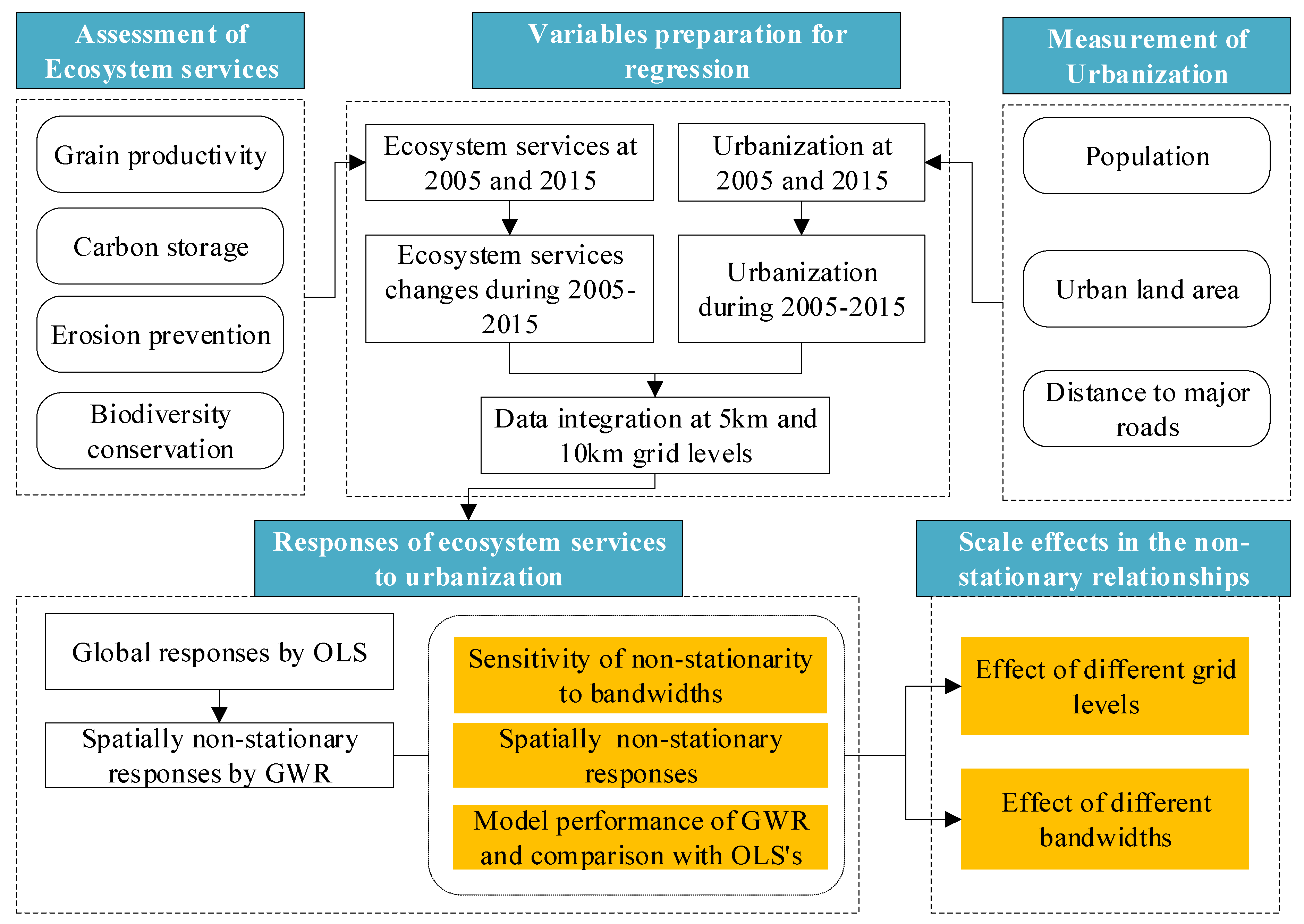
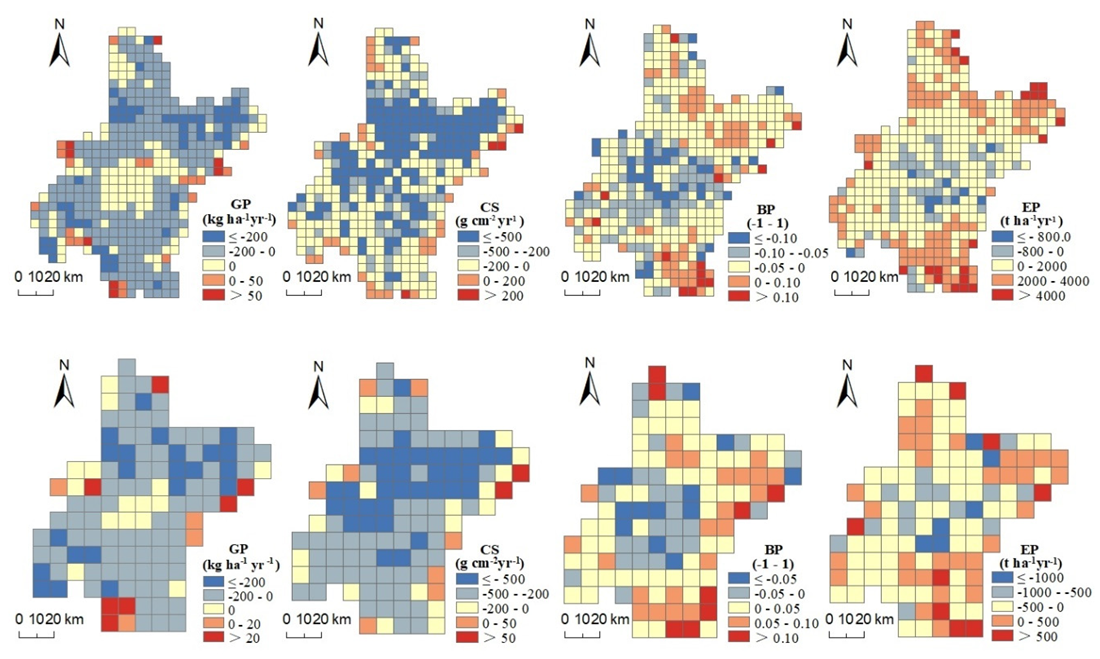
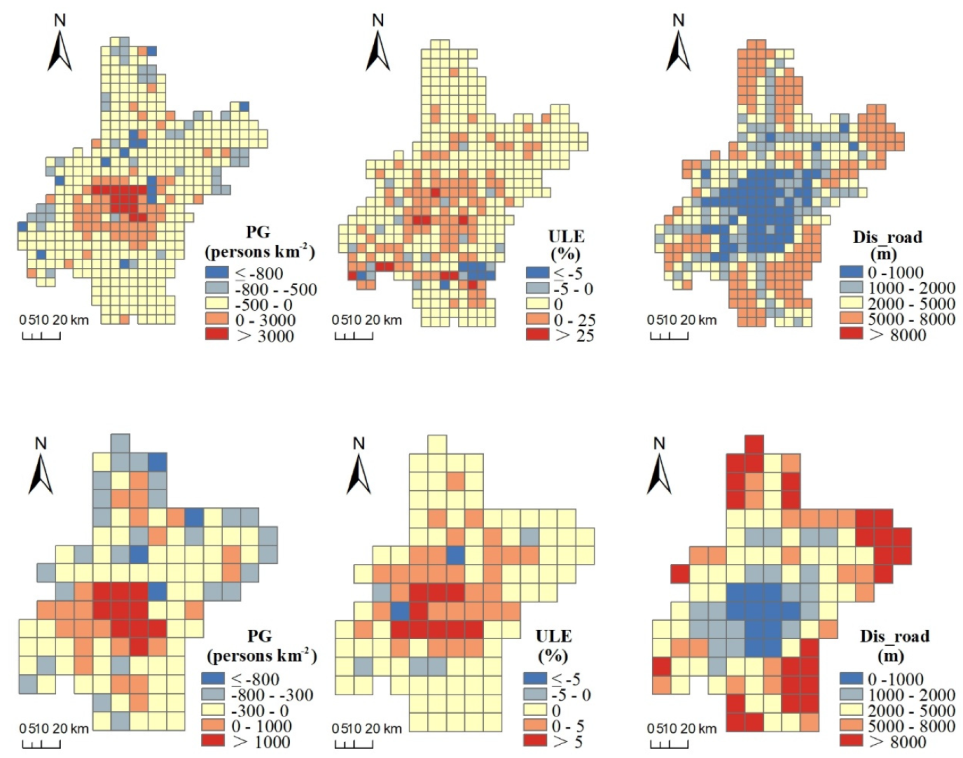

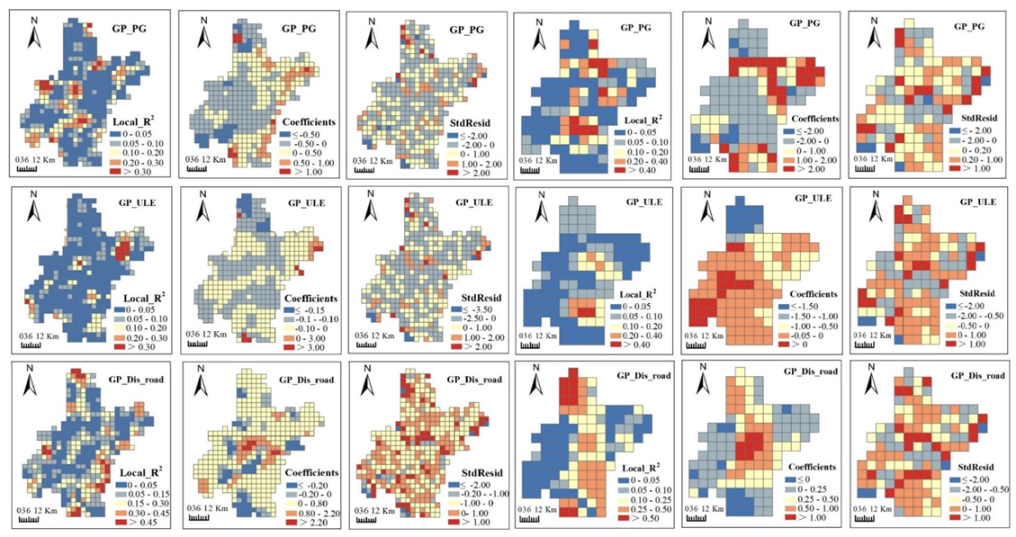
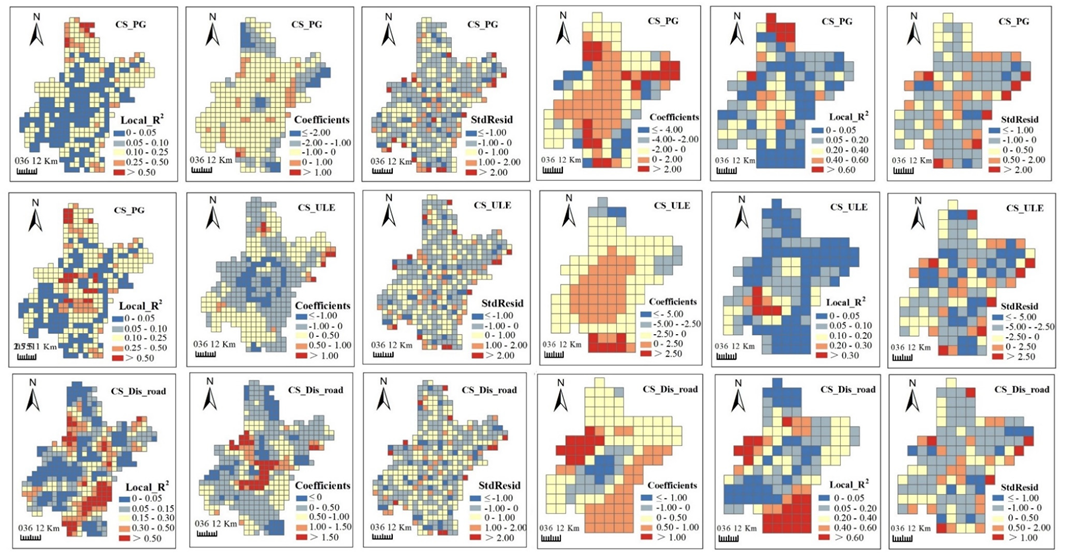
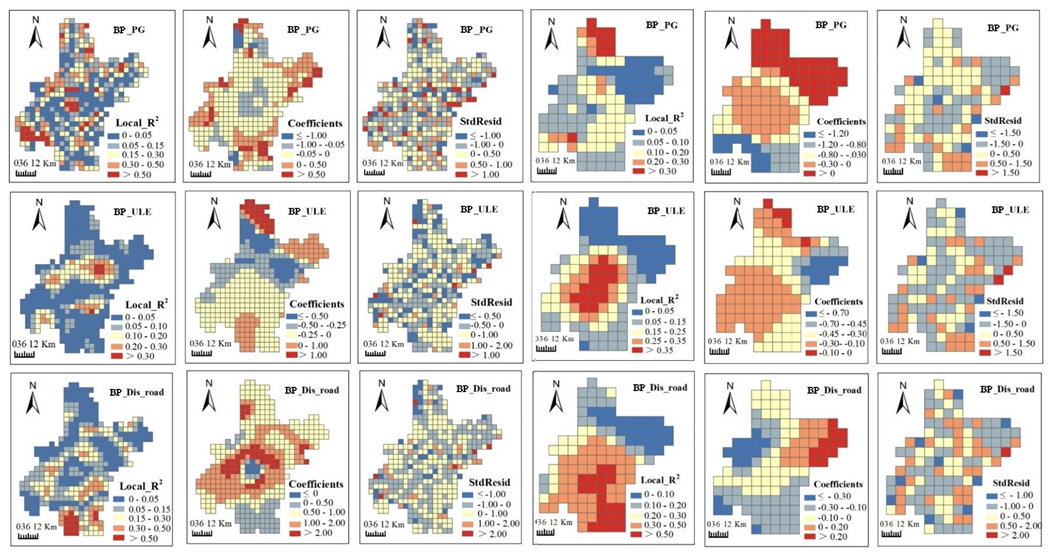

| ESs | 5 km Grid Level | 10 km Grid Level | ||
|---|---|---|---|---|
| Moran’s I | p-Value | Moran’s I | p-Value | |
| GP | 0.4895 ** | 0.001 | 0.4788 ** | 0.001 |
| CS | 0.5032 ** | 0.001 | 0.3974 ** | 0.001 |
| BP | 0.1818 ** | 0.001 | 0.0155 | 0.153 |
| EP | 0.0685 ** | 0.001 | 0.0853 ** | 0.002 |
| Grid Scales | ESs | PG | ULE | Dis_Road |
|---|---|---|---|---|
| 5 km grid level | GP | −0.6597 ** | −0.3937 ** | 0.4104 ** |
| CS | −0.1228 ** | −0.192 | 0.4372 ** | |
| BP | −0.1552 ** | −0.3391 * | 0.1109 ** | |
| EP | −0.5527 ** | −0.3114 ** | 0.2925 ** | |
| 10 km grid level | GP | −0.4105 ** | −0.3382 ** | 0.3768 ** |
| CS | −0.1068 * | −0.1092 * | 0.3473 ** | |
| BP | 0.1307 | −0.1418 ** | 0.0764 | |
| EP | −0.5846 ** | −0.2898 ** | 0.5109 ** |
| Grid Scales | ESs | PG | ULE | Dis_Road | |||
|---|---|---|---|---|---|---|---|
| Adjusted R2(g) | Adjusted R2(o) | Adjusted R2(g) | Adjusted R2(o) | Adjusted R2(g) | Adjusted R2(o) | ||
| 5 km grid | GP | 0.7852 | 0.1461 | 0.7667 | 0.1305 | 0.7780 | 0.1374 |
| CS | 0.7667 | 0.1433 | 0.5157 | 0.1044 | 0.5527 | 0.2138 | |
| BP | 0.5459 | 0.1164 | 0.2703 | 0.1275 | 0.3261 | 0.0311 | |
| EP | 0.6039 | 0.1581 | 0.6009 | 0.1385 | 0.6347 | 0.1387 | |
| 10 km grid | GP | 0.6212 | 0.1479 | 0.6721 | 0.1409 | 0.6185 | 0.1284 |
| CS | 0.5025 | 0.1083 | 0.4259 | 0.1012 | 0.4298 | 0.1439 | |
| BP | 0.3659 | 0.1075 | 0.1582 | 0.1301 | 0.3961 | 0.1229 | |
| EP | 0.5546 | 0.1120 | 0.4819 | 0.1686 | 0.6182 | 0.2422 | |
| Grid Scales | ESs | PG | ULE | Dis_road | |||
|---|---|---|---|---|---|---|---|
| AICc(g) | AICc(o) | AICc(g) | AICc(o) | AICc(g) | AICc(o) | ||
| 5 km grid | GP | −575.3537 | −42.0953 | −547.3657 | −35.5334 | −565.1398 | −81.9734 |
| CS | −388.1993 | −60.6587 | −387.1123 | −160.103 | −417.0996 | −258.3107 | |
| BP | −946.9034 | −819.9337 | −914.41 | −824.5872 | −936.6223 | −826.0349 | |
| EP | −618.2621 | −325.9104 | −607.9558 | −317.5856 | −641.6658 | −361.2498 | |
| 10 km grid | GP | −325.1587 | −3.094 | −368.8998 | −2.2024 | −387.2158 | −12.7435 |
| CS | −125.5125 | −35.6639 | −157.1558 | −36.521 | −213.0158 | −55.4822 | |
| BP | −258.1158 | −122.3117 | −264.1596 | −138.24 | −736.1985 | −124.19 | |
| EP | −236.8857 | −17.8764 | −128.1158 | −25.845 | −1167.6618 | −37.052 | |
| Grid Scales | ESs | PG | ULE | Dis_Road | |||
|---|---|---|---|---|---|---|---|
| Moran’s I of Residuals(g) | Moran’s I of Residuals(o) | Moran’s I of Residuals(g) | Moran’s I of Residuals(o) | Moran’s I of Residuals(g) | Moran’s I of Residuals(o) | ||
| 5 km grid | GP | 0.0442 | 0.6587 ** | 0.0409 | 0.7427 ** | 0.0477 | 0.7237 ** |
| CS | 0.0645 | 0.4218 ** | 0.0798 | 0.4169 ** | 0.0491 | 0.3638 ** | |
| BP | −0.0990 | 0.2368 ** | 0.042 | 0.3074 ** | −0.0132 | 0.3128 ** | |
| EP | 0.0065 | 0.5243 ** | 0.0244 | 0.5367 ** | 0.0376 | 0.5042 ** | |
| 10 km grid | GP | 0.0687 | 0.6374 ** | 0.0029 | 0.6127 ** | 0.0698 | 0.617 ** |
| CS | 0.0512 * | 0.3310 ** | 0.0514 | 0.3196 | 0.0584 | 0.3478 ** | |
| BP | 0.0125 | 0.1514 ** | 0.0841 * | 0.1391 | −0.0189 | 0.2475 ** | |
| EP | 0.0089 | 0.4614 ** | 0.0358 | 0.3477 ** | −0.0280 | 0.4064 ** | |
© 2020 by the authors. Licensee MDPI, Basel, Switzerland. This article is an open access article distributed under the terms and conditions of the Creative Commons Attribution (CC BY) license (http://creativecommons.org/licenses/by/4.0/).
Share and Cite
Zhang, Y.; Liu, Y.; Pan, J.; Zhang, Y.; Liu, D.; Chen, H.; Wei, J.; Zhang, Z.; Liu, Y. Exploring Spatially Non-Stationary and Scale-Dependent Responses of Ecosystem Services to Urbanization in Wuhan, China. Int. J. Environ. Res. Public Health 2020, 17, 2989. https://doi.org/10.3390/ijerph17092989
Zhang Y, Liu Y, Pan J, Zhang Y, Liu D, Chen H, Wei J, Zhang Z, Liu Y. Exploring Spatially Non-Stationary and Scale-Dependent Responses of Ecosystem Services to Urbanization in Wuhan, China. International Journal of Environmental Research and Public Health. 2020; 17(9):2989. https://doi.org/10.3390/ijerph17092989
Chicago/Turabian StyleZhang, Yan, Yanfang Liu, Jiawei Pan, Yang Zhang, Dianfeng Liu, Huiting Chen, Junqing Wei, Ziyi Zhang, and Yaolin Liu. 2020. "Exploring Spatially Non-Stationary and Scale-Dependent Responses of Ecosystem Services to Urbanization in Wuhan, China" International Journal of Environmental Research and Public Health 17, no. 9: 2989. https://doi.org/10.3390/ijerph17092989
APA StyleZhang, Y., Liu, Y., Pan, J., Zhang, Y., Liu, D., Chen, H., Wei, J., Zhang, Z., & Liu, Y. (2020). Exploring Spatially Non-Stationary and Scale-Dependent Responses of Ecosystem Services to Urbanization in Wuhan, China. International Journal of Environmental Research and Public Health, 17(9), 2989. https://doi.org/10.3390/ijerph17092989







